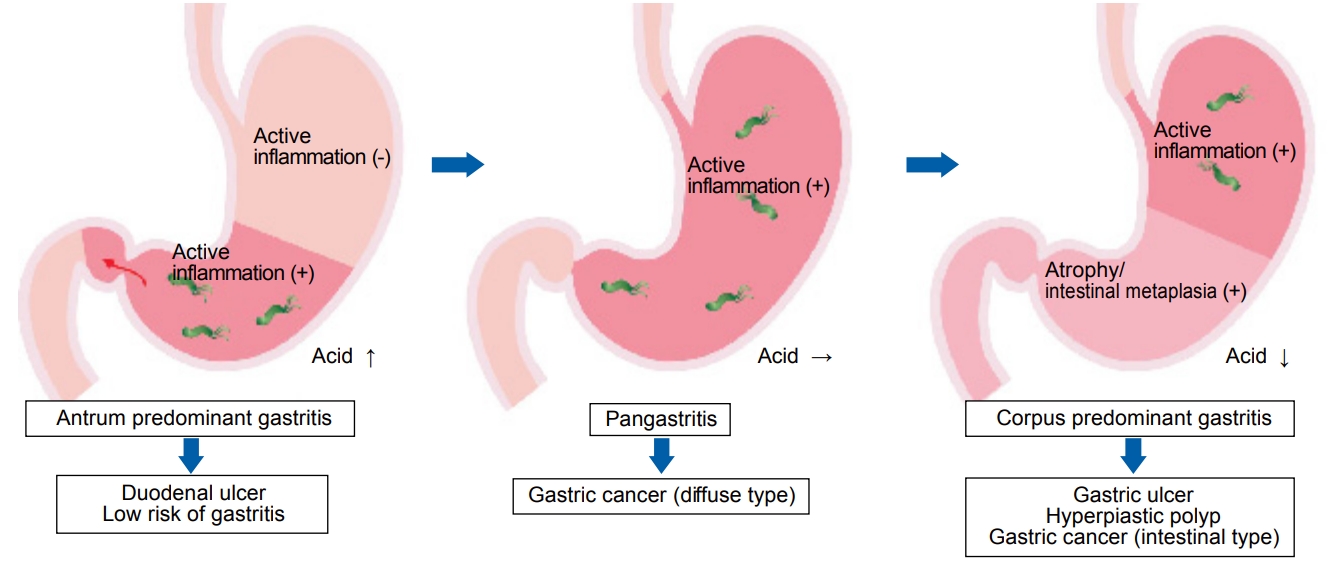1. Kamada T, Haruma K, Inoue K, Shiotani A.
Helicobacter pylori infection and endoscopic gastritis -Kyoto classification of gastritis. Nihon Shokakibyo Gakkai Zasshi 2015;112:982ŌĆō993.

2. Haruma K, Kato M, Inoue K, Murakami K, Shibata T. Kyoto classification of gastritis. 1th ed. Tokyo: Nihon Medical Center, 2014.
3. Haruma K, Kato M, Inoue K, Murakami K, Shibata T. Kyoto classification of gastritis. 2nd ed. Tokyo: Nihon Medical Center, 2018.
4. Kato S, Matsukura N, Tsukada K, et al.
Helicobacter pylori infection-negative gastric cancer in Japanese hospital patients: incidence and pathological characteristics. Cancer Sci 2007;98:790ŌĆō794.



5. Houghton J, Wang TC.
Helicobacter pylori and gastric cancer: a new paradigm for inflammation-associated epithelial cancers. Gastroenterology 2005;128:1567ŌĆō1578.


6. Uemura N, Okamoto S, Yamamoto S, et al.
Helicobacter pylori infection and the development of gastric cancer. N Engl J Med 2001;345:784ŌĆō789.


7. Kato M, Asaka M. Recent knowledge of the relationship between
Helicobacter pylori and gastric cancer and recent progress of gastroendoscopic diagnosis and treatment for gastric cancer. Jpn J Clin Oncol 2010;40:828ŌĆō837.



8. Rugge M, Meggio A, Pennelli G, et al. Gastritis staging in clinical practice: the OLGA staging system. Gut 2007;56:631ŌĆō636.


9. Capelle LG, de Vries AC, Haringsma J, et al. The staging of gastritis with the OLGA system by using intestinal metaplasia as an accurate alternative for atrophic gastritis. Gastrointest Endosc 2010;71:1150ŌĆō1158.


10. Tsai YC, Hsiao WH, Yang HB, et al. The corpus-predominant gastritis index may serve as an early marker of
Helicobacter pylori-infected patients at risk of gastric cancer. Aliment Pharmacol Ther 2013;37:969ŌĆō978.


13. Kamada T, Tanaka A, Yamanaka Y, et al. Nodular gastritis with
Helicobacter pylori infection is strongly associated with diffuse-type gastric cancer in young patients. Dig Endosc 2007;19:180ŌĆō184.

14. Nishibayashi H, Kanayama S, Kiyohara T, et al.
Helicobacter pylori-induced enlarged-fold gastritis is associated with increased mutagenicity of gastric juice, increased oxidative DNA damage, and an increased risk of gastric carcinoma. J Gastroenterol Hepatol 2003;18:1384ŌĆō1391.


15. Kato M. Endoscopic findings for risk stratification of gastric cancer. In: Haruma K, editors. Kyoto classification of gastritis. 2nd ed. Tokyo: Nihon Medical Center, 2018. p. 120ŌĆō126.
18. Ono S, Kato M, Tsuda M, et al. Lavender color in linked color imaging enables noninvasive detection of gastric intestinal metaplasia. Digestion 2018;98:222ŌĆō230.


20. Shichijo S, Hirata Y, Niikura R, Hayakawa Y, Yamada A, Koike K. Association between gastric cancer and the Kyoto classification of gastritis. J Gastroenterol Hepatol 2017;32:1581ŌĆō1586.


21. Saka A, Yagi K, Nimura S. OLGA- and OLGIM-based staging of gastritis using narrow-band imaging magnifying endoscopy. Dig Endosc 2015;27:734ŌĆō741.












